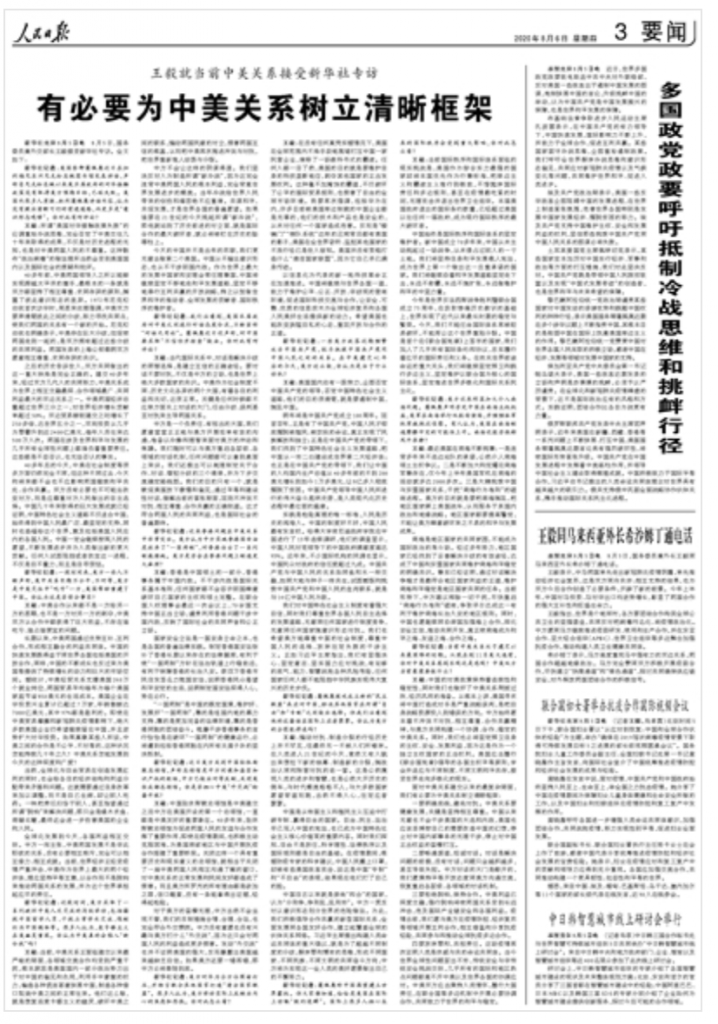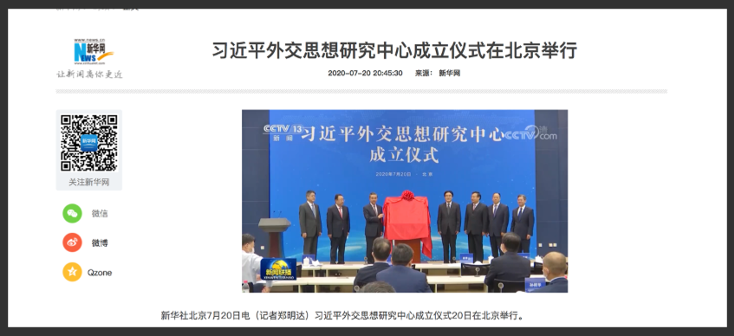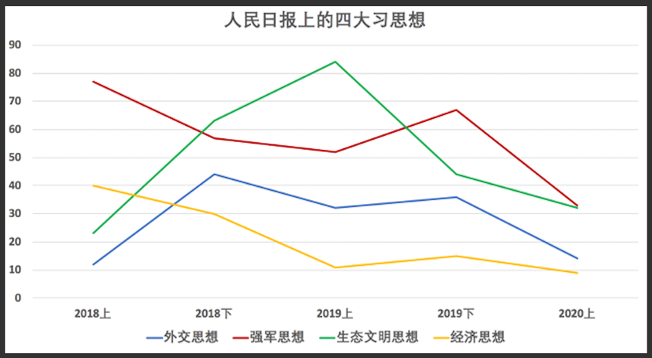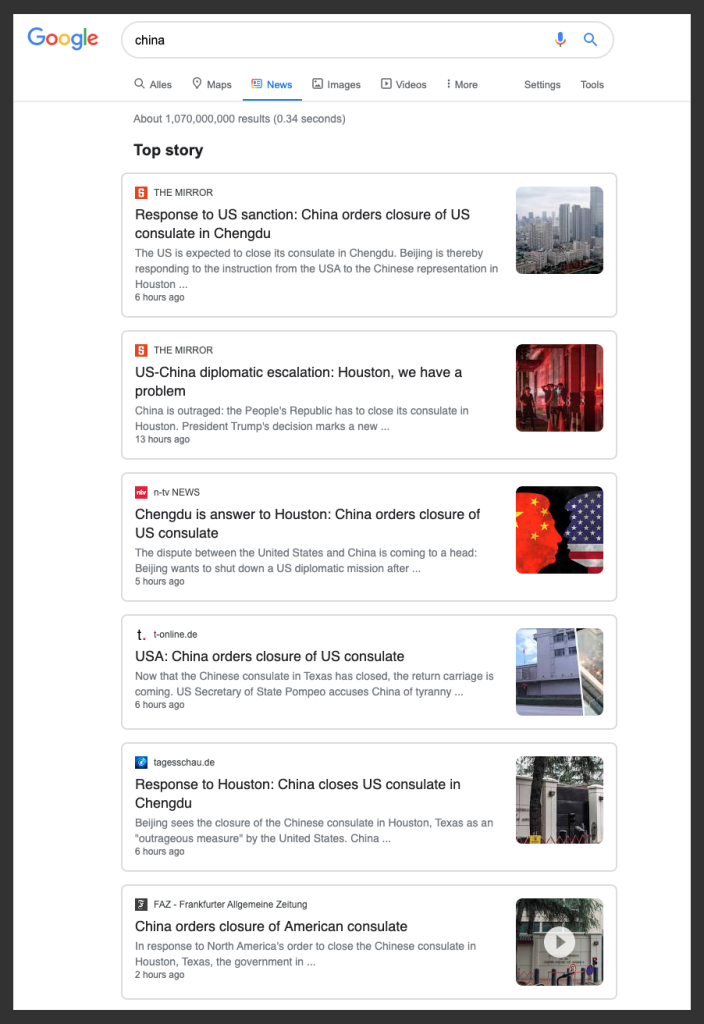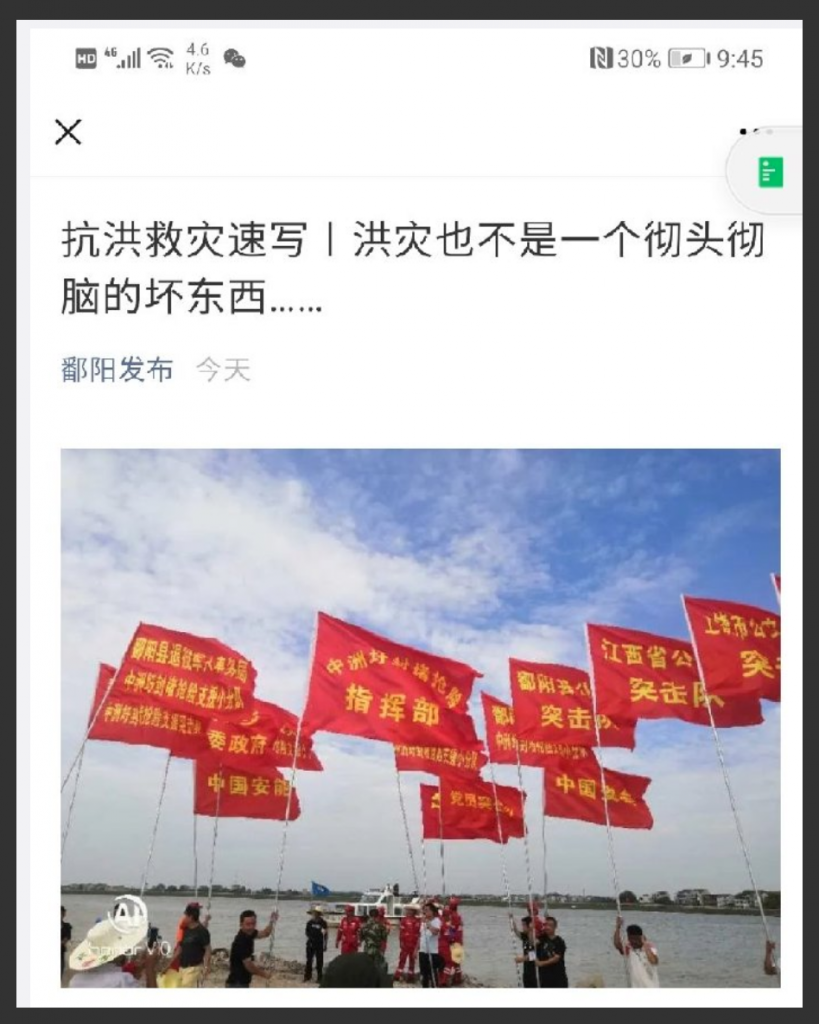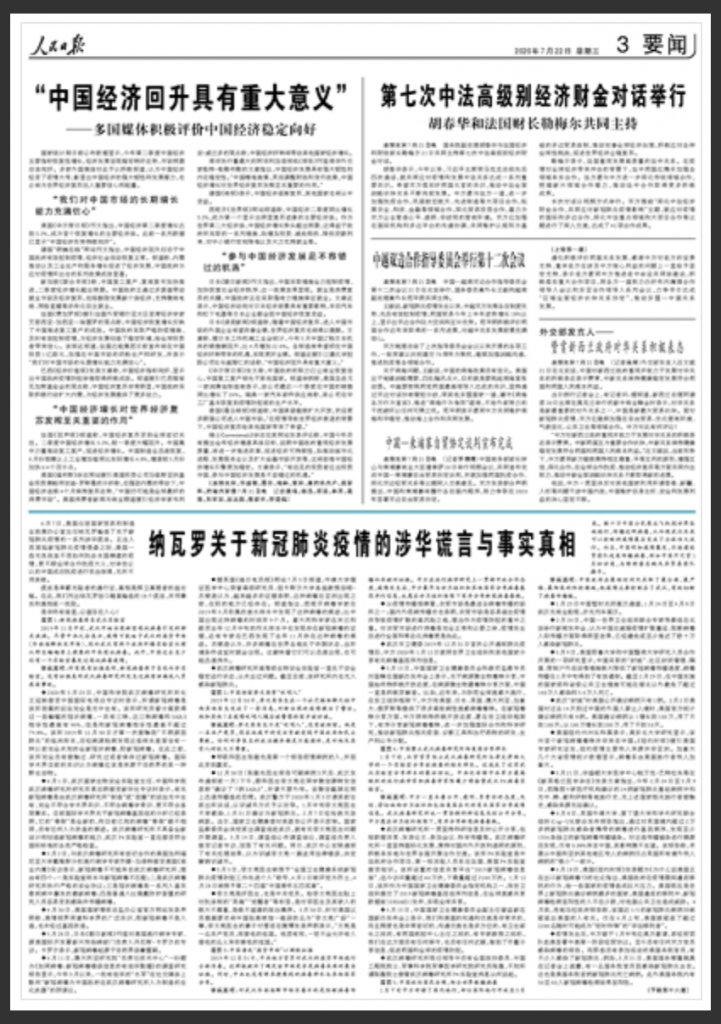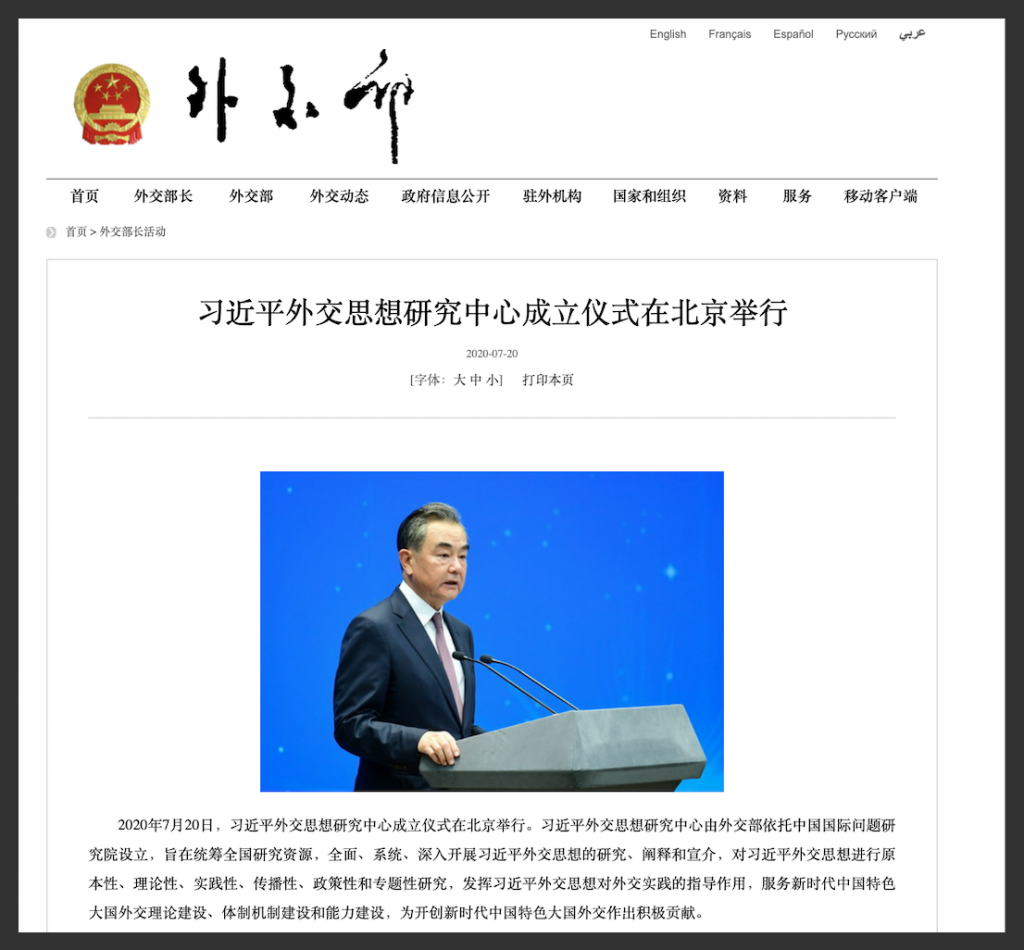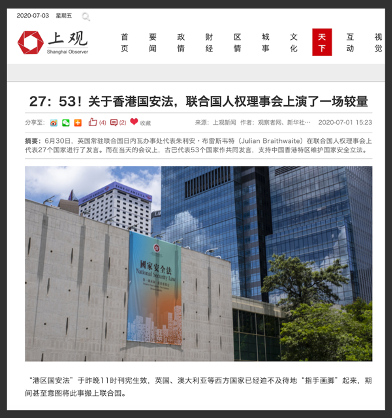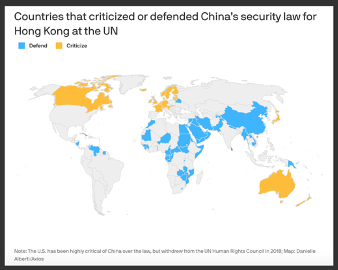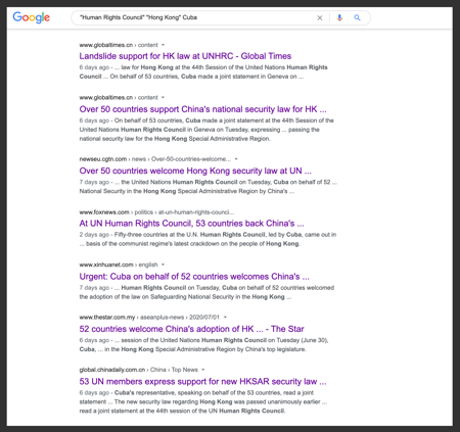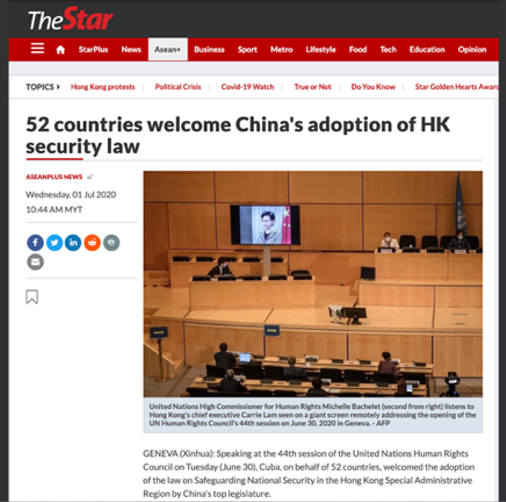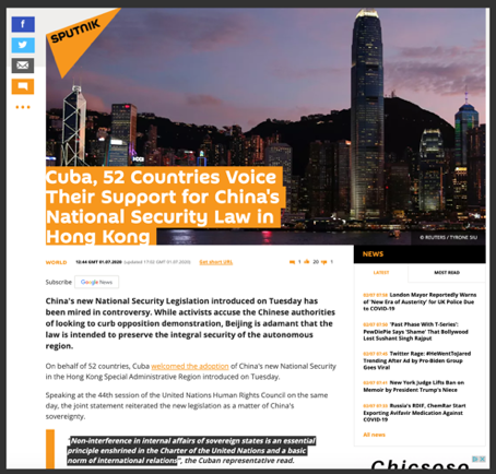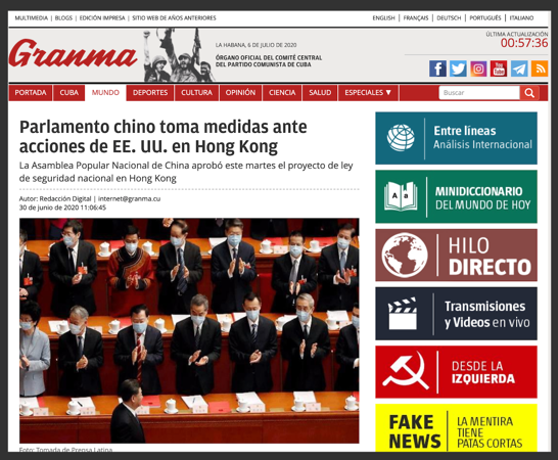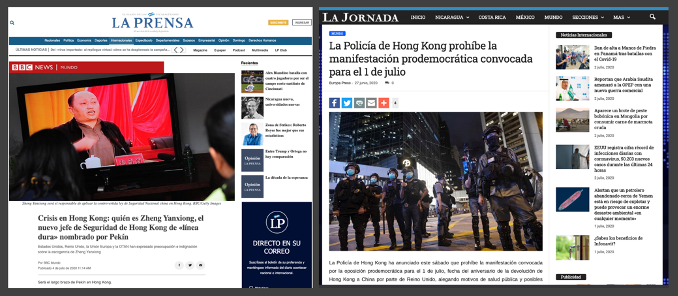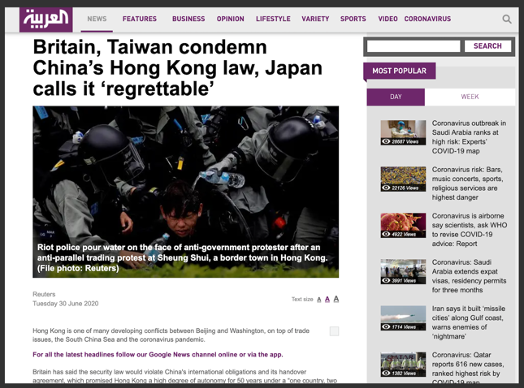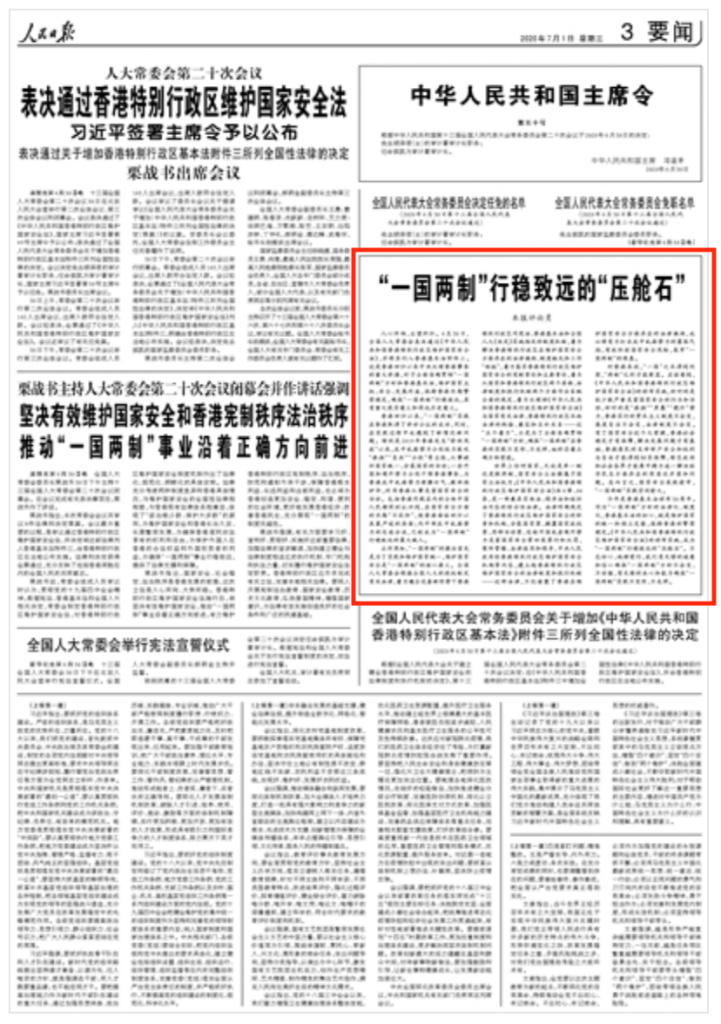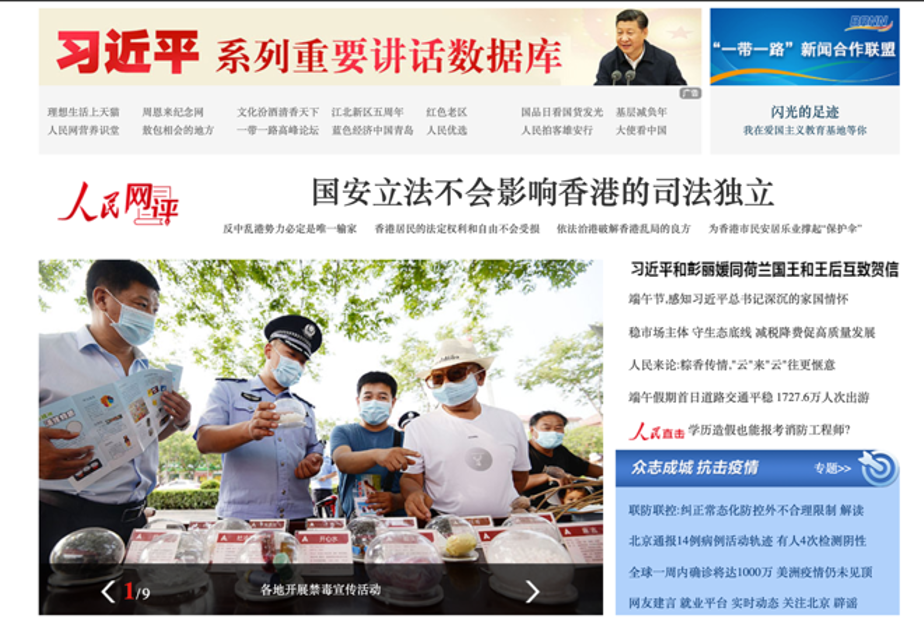Chinese Foreign Minister Wang Yi (王毅) has been getting what seems to be a clear uptick in attention in
China’s party-state media ever since his launch late last month of a new “Research
Center for Xi Jinping Thought on Diplomacy.” Both yesterday and today, media
have widely reported Wang’s “exclusive interview” with the official Xinhua News
Agency. A Chinese transcript of the interview appears prominently on page
three of today’s People’s Daily.
Releasing a video of the interview yesterday, Xinhua emphasized
Wang’s remarks about the US being
unqualified to lead a coalition of “clean countries” on data protection and
5G technology, and his point that
US “bullying” was challenging the global order. CGTN
reported that Wang had drawn “a clear bottom line” for China’s relationship
with the United States, set out the conditions for cooperation, and “clarified
China’s position” on a number of key issues.
What many media seem to be emphasizing today as the central takeaway – though there are plenty of broadsides in the interview – is that China remains calm, cool-headed and ready to talk in the face of an “impulsive and restless” United States. Indeed, the headline on the interview transcript appearing in the People’s Daily today suggests China wishes to send the signal that its door is open. The headline reads: “There is a Need to Create a Clear Framework for China-US Relations.”
That said, the positions Wang Yi reiterates on core issues, from Huawei to Hong Kong, are unlikely to move the conversation. They boil down to a refusal to concede any ground, pinning the blame purely on the “arrogance” and “Cold War thinking” of “certain US politicians,” and a “conspiracy” to “resurrect the ghost of McCarthyism.” (The rather less colorful official English translation is simply “resurrect McCarthyism.”) One would be hard-pressed to detect anywhere in Wang’s remarks an attempt to really understand the anxieties about China that have seized not just “certain politicians” in the US, but governments and a broad range of constituencies, from academics and activists to business groups, in many places in the world.
Wang’s answer to concerns over Huawei and 5G, for example, boils down to a simple insistence that Chinese technology products are safe, and a reminder that it was the US that gave us surveillance programs like Prism and Echelon. On the question of rights and freedoms, he notes that “freedom, democracy and rule of law were long ago written into China’s Constitution, and have already become an important part of the socialist core values of socialism with Chinese characteristics.”
Today, the Ministry of Foreign Affairs released a full transcript of Wang’s remarks in English.
A few things to note about the transcript of Wang’s interview.
First, it seems that he did not address the issue of Taiwan or the planned
trip by US Health Secretary Alex M. Azar II. Second, there is no mention of Xinjiang, and
issue that has focussed concern internationally. Third, there is no reference
in the interview to the Belt and Road Initiative (BRI), or to the “ancient silk
road,” though BRI has of course been central to China’s foreign policy in
recent years. One can guess that the decision to omit mention of the BRI might
have been prompted by the fact that it too has grown controversial, becoming a “global
trail of trouble.”
Finally, we note that there is no mention in the interview of “Xi Jinping Thought on Diplomacy,” a phrase Wang Yi has emphasized recently as a shorthand for China’s new approach to foreign policy in the “new era.” The omission perhaps makes sense if we understand, as we have written about quite a bit, that “Xi Jinping Thought on Diplomacy” is largely a phrase for internal CCP consumption, more about consolidating Xi’s power as China’s “core” leader than attempting to focus or explain Chinese diplomacy to the rest of the world. Two phrases that are referenced in Wang’s interview are “community of common destiny for mankind,” mentioned twice, and “new type of international relations.”
THE TRANSCRIPT:
Xinhua: US Secretary of State Mike Pompeo asserted in his speech at the Richard Nixon Presidential Library that the policy of engagement with China pursued by successive US administrations since President Nixon’s has not produced its goal and has failed. Many people in the United States question his assertion, saying it was more of an “ideological rant” without any clear or feasible pathway forward. What is your comment?
Wang Yi: The assertion that US policy of engagement with China has failed is just a rehash of the Cold War mentality. It turns a blind eye to all that has been achieved in China-US relations over the past decades, shows ignorance of the historical process and lack of respect for the Chinese and American peoples. This is a political virus which is understandably questioned and rebuked by people in the United States and the international community.
Over four decades ago, leaders of China and the United States made the handshake across the vast Pacific Ocean. What made this possible was that both countries adhered to the principle of mutual respect and seeking common ground while putting aside ideological differences.
During President Nixon’s visit to China in 1972, Chinese Premier Zhou Enlai said that China and the US needed to be clear about our differences and find common ground, so as to reach a new starting point in bilateral ties. President Nixon responded that our two countries have great differences, and what brings us together is that we have common interests which transcend those differences. The Shanghai Communique issued by the two countries encapsulated their consensus to respect each other and seek common ground while setting aside differences.
What has happened since then demonstrates that this monumental choice made by the two sides is the right one. Over the past 40 years and more since the two countries entered into diplomatic ties, several generations of Chinese and Americans have worked together to advance China-US relations. As a result, bilateral ties have become one of the most deeply interwoven relationships in the world with broadest cooperation areas and most extensive common interests.
China and the US now account for over one-third of global economic output and over 50% of global growth. Bilateral trade volume has increased by over 250 times since the early days of diplomatic ties and takes up one-fifth of the global total. Two-way investment has jumped from almost zero to nearly US$240 billion, and annual two-way visits by the two peoples have reached five million. The two countries shoulder important responsibilities for almost all global issues concerning world peace and development. No one can deny these facts.
Forty years on, while China and the US are quite different in social system and many other aspects, such differences have not affected the peaceful coexistence and cooperation between the two countries, and they should not affect their bilateral ties in the future. It is neither necessary nor possible for the two sides to change each other. Instead, we should respect the choice independently made by the people of the other side.
China’s major achievements in the past decades show that the path of socialism with Chinese characteristics fits China and enjoys the most extensive and firm support of the Chinese people. It has also benefited the world and people of other countries, including the American people.
China will continue to pursue development and progress to meet the desire of its people and make new, even greater contributions to mankind. Anyone who attempts to derail this process can only end in failure.
Xinhua: Some people in the United States claim that the China-US relationship has long been unfair and not reciprocal, and that the US has rebuilt China but it has been taken advantage of. Do you think this is the case?
Wang Yi: China-US cooperation has never been a case of one party giving favor to the other, or one party taking advantage of the other. Both countries have benefited much from this cooperation, and no one is being taken advantage of or being ripped off.
Mutually beneficial cooperation over the years have turned China and the US into a community with shared interests. China has achieved rapid growth in part thanks to its opening-up to and cooperation with the rest of the world, including the US. China’s continued growth has also created sustained demand and an enormous market for the US and other countries.
Statistics show that China-US business ties support 2.6 million American jobs. Trade with China helps each American family save US$850 every year. Over 70,000 American businesses have made investment in China with a total sales volume of US$700 billion. Among them, 97% are making a profit. Even with the trade friction and COVID-19, the vast majority of American companies in China still want to stay and are doubling down on investment in China.
If China-US cooperation were unfair and not reciprocal, how could it have continued for several decades? How could China-US ties have come such a long way?
Globalization and free trade have delivered development dividends, but they have also created tensions for countries and affected their economic structures and distribution of interests. This should be dealt with through internal reform. Acting like a sick person who forces others to take medicine for his own illness or even resorting to decoupling will not work. It is the American companies and people that will get badly hurt.
In the globalized world today, the interests of countries are closely intertwined. The development of China and of the US is not a zero sum game, and we should not reject each other. What we should do is to draw on each other’s strength to achieve common development.
As COVID-19 takes its toll on the global economy, China and the US, the world’s two largest economies, should work for mutual benefit on an equal footing, stop attempts at decoupling and advance the relationship through cooperation, and live up to their responsibility for the world.
Xinhua: The United States has recently made a number of moves that undermine people-to-people and cultural exchanges with China. It has harassed Chinese students in the US, obstructed normal academic exchange, and imposed restrictions on Chinese media operating in the United States. Many people are concerned that this is a resurgence of McCarthyism. Do you think the two countries will fall into a new Cold War?
Wang Yi: China-US relations are facing the gravest challenge since the establishment of diplomatic ties, and their exchanges and cooperation in many areas are being seriously disrupted. The root cause is that some American politicians who are biased against and hostile to China are using their power to smear China with fabrications and impede normal ties with China under various pretexts. What they want is to revive McCarthyism in an attempt to undermine US relations with China, stoke hostility between the two peoples, and erode trust between the two countries. Ultimately, they want to drag China and the US into renewed conflict and confrontation and plunge the world into chaos and division again.
China will not allow these people to get their way. We reject any attempt to create a so-called “new Cold War”, because it contravenes the fundamental interests of the Chinese and American peoples and the global trend toward development and progress. The Cold War, which inflicted great sufferings to the world, should not be allowed to repeat itself. Peace and development is what all countries aspire to. Anyone who tries to start a new Cold War in the 21st century will be on the wrong side of history and will only be remembered as the one who has upended international cooperation.
Today’s China is not the former Soviet Union. We have no intention of becoming another United States. China does not export ideology, and never interferes in other countries’ internal affairs. As the world’s largest developing country and a permanent member of the UN Security Council, China will stay committed to peaceful development and to pursuing an opening-up strategy of mutual benefit. China will continue to promote global peace and development and uphold the international order.
Xinhua: We have noted that the current US administration shuns dialogue with China and keeps claiming that dialogue is futile. Pompeo even recently called for taking a “distrust and verify” approach toward China. What is your view on such moves?
Wang Yi: In international relations today, dialogue is the right way for settling issues and building trust. Favoring dialogue over confrontation is not only China’s position. It is also the consensus of the overwhelming majority of countries. China and the US are two major countries with different social systems, histories and cultures, and each has its own interests and concerns. This is natural. But what is important is that no one should unilaterally shut the door for dialogue at any time. Difference, misjudgment or confrontation should not be allowed to dominate their bilateral relations.
China is a major and responsible country. We are open and above board, and we are ready to enter into candid, effective consultation with the US side and make cool-headed and sensible response to the impulsive moves and anxiety of the US side. We are ready to restart the dialogue mechanisms with the US side at any level, in any area and at any time. All issues can be put on the table for discussion. We have proposed that the two countries draw up three lists respectively on cooperation, dialogue and issues that need proper management, and draw up a road-map for future interactions. Our message is quite clear: We urge the US to stop acting with arrogance and prejudice, but enter into constructive dialogue with us on an equal footing. We hope that it will work with us to ease current tensions and put the relations back onto the right track of no conflict, no confrontation, mutual respect and win-win cooperation. This serves the shared interests of the two peoples and meets the expectation of the international community.
Xinhua: Recently, Hong Kong has become a prominent issue in China-US relations. The US believes that by enacting the national security legislation, China has given up One Country, Two Systems. It has imposed a number of sanctions on Hong Kong. Do you expect the US to make more trouble on the Hong Kong issue?
Wang Yi: Hong Kong is part of China’s territory and Hong Kong affairs fall within China’s internal affairs. Non-interference in other countries’ internal affairs is a basic norm governing international relations, and no country will allow other countries to flagrantly sabotage its sovereignty or territorial integrity. At the recent session of the UN Human Rights Council, over 70 countries expressed support of China’s just stance and condemned the attempts to use the Hong Kong issue to interfere in China’s internal affairs. This speaks volumes for the common and just position of the international community.
National security legislation underpins the very survival of any country, and it is a common legal practice of all countries. The legislation on safeguarding national security in Hong Kong has plugged the long-standing legal loopholes in Hong Kong. It will ensure both the long-term implementation of the policy of One Country, Two Systems on the basis of rule of law and durable security and stability of Hong Kong. Several million residents of Hong Kong signed a petition in support of the legislation, which demonstrates their longing for peace and stability in Hong Kong and their strong support for the national security legislation.
China is committed to the policy of One Country, Two Systems. With the strong support from the mainland, an improved legal environment, and the united efforts of our Hong Kong compatriots, we can surely uphold and better implement the policy of One Country, Two Systems. The gross interference in Hong Kong affairs, be it in words or action, can only undermine the sound implementation of the policy of One Country, Two Systems. It will meet with the firm rejection from all the Chinese people, including the people of Hong Kong.
Xinhua: The US recently closed the Chinese Consulate-General in Houston, claiming that it was a hub of spying and intellectual property theft. China made a reciprocal response by closing the US Consulate-General in Chengdu. Are you concerned that this will lead to escalation in a China-US “diplomatic war”?
Wang Yi: The Chinese Consulate-General in Houston was the first Consulate-General opened by China in the US after the establishment of the diplomatic ties, and it was always an important symbol of China-US friendship. Over the past 40 plus years, the Chinese Consulate-General in Houston played a significant role in promoting friendship and cooperation between the Chinese and American peoples. Despite the difficulties encountered during the COVID-19 epidemic, it served as a crucial bridge for boosting cooperation against coronavirus between the US southern states and China. Closing such a consulate-general that bears both historical and current significance is closing a window for exchange and mutual understanding between the Chinese and Americans. This move has undermined the normal growth of China-US relations and the friendship between the two peoples. All the excuses for closure claimed by the US side are nothing but fabrications designed to slander China. None of them is backed by any evidence, and none of them can stand up to scrutiny.
Naturally, China would not swallow this arbitrary and unscrupulous US move. Our countermeasure is legitimate, justified and lawful, and it fully conforms to diplomatic norms. China has no intention to fight a “diplomatic war” with the US as it will only hurt the interests of the two peoples even more. Starting a “diplomatic war” does not prove the strength of the US. Quite the contrary, it only exposes the increasing lack of confidence of the US. If the US is bent on going down the wrong path, China is ready to make due response.
Xinhua: The US is going after Huawei in every possible way, and has declared to build a coalition of “clean countries” to counter China. Many see this as a reflection of US anxiety and fear. What is your take on this?
Wang Yi: Without any solid evidence, the US has launched a global campaign against a private Chinese company. This is a textbook example of bullying. Everyone can see easily and clearly that the US goal is to keep its monopoly in science and technology but deny other countries the legitimate right to development. It doesn’t even bother to disguise its bullying. This not only violates the international rules of fair trade, but also hurts the free global market environment.
I’d like to stress again that Huawei and many other Chinese companies, unilaterally sanctioned by the US, are innocent. Their technologies and products are safe to use, and they have never done any harm to any country. In stark contrast, the US is behind such scandals as PRISM and ECHELON. It conducts wire-tapping and mass surveillance around the globe, and these wrongful acts are already an open secret. The US is not qualified to build a coalition of “clean countries” because itself is dirty allover.
The new science and technology revolution, driven by information technology, is picking up speed. China will continue to work with all countries to maintain a fair, just, open and non-discriminatory business environment, promote international exchanges and cooperation in science and technology, and ensure that safe, reliable and quality information technology will boost global economic recovery and help improve people’s lives around the world. We hope that the US will give up its obsession with its narrow self-interest, and return to the right track of openness and cooperation.
Xinhua: Some US politicians are making fierce attacks on the Communist Party of China (CPC), attempting to pit it against the Chinese people. Forty-one years after China and the US established diplomatic relations, what do you think is the US motive in so doing?
Wang Yi: There have always been forces in the United States attempting to rebut the leadership role of the CPC and China’s path of socialism with Chinese characteristics. Their purpose is notably obvious, i.e., to contain and destabilize China.
Next year will mark the 100th anniversary of the CPC. Over the past century, the CPC has led the Chinese people to discard colonial rule and exploitation and realize national liberation and independence. It is the CPC that has led us in blazing the path of socialism with Chinese characteristics, turning the once impoverished country into the world’s second largest economy. It is under the CPC leadership that China’s per capita GDP has grown from less than US$200 forty years ago to over US$10,000 today, and over 800 million people have been lifted out of poverty. The great endeavor of the Chinese people under the CPC leadership has been recorded in the history of modernization as an outstanding, epoch-making chapter.
Practice is the sole criterion of truth, and the people are the judges of history. Does China’s system work for the country? The Chinese people know better than anyone else. The Harvard Kennedy School’s surveys in China which extended 13 years suggest that over 93% of the Chinese people are satisfied with the central government which is led by the CPC. Many international polls in recent years also show that at least 90% of the Chinese people trust their government. The relationship between the CPC and the Chinese people is as close as between “fish and water” and between “soil and seed”. Those who attempt to break this strong bond is making themselves enemies of the 1.4 billion Chinese people.
We have great confidence in our path of socialism with Chinese characteristics. In the meantime, we also respect the development paths chosen by other nations. We are not interested in rivalry of systems, or ideological confrontation with any country. Likewise, we hope that the US will respect China’s social system and the Chinese people’s choice, and give up its failed interventionism. As President Xi Jinping pointed out, we have the strong determination, resolve and national strength to overcome all challenges. We have the courage, ability and wisdom to prevail over all risks and tests. No country or individual can hold back the historic march toward the great rejuvenation of the Chinese nation.
Xinhua: Pompeo is calling for a new alliance of democracies against China, and forcing other countries to choose between what he called “freedom” and “tyranny”. But we noticed that very few nations answered the call. Do you think that the US will get what it wants?
Wang Yi: Instigation for confrontation and division was not rare in history, but was all rebuked by the people. In the 21st century, it is inconceivable that some people intend to draw an iron curtain, stoke new division, advocate identity politics and bloc rivalry, and resort to other old tricks. This is a blatant contempt of human progress and wisdom as well as a regression of history. It goes against the trend of our times and the will of most nations. Naturally it has no support of the people, and few backing in the world.
China achieved freedom from imperialism and colonialism. Freedom, democracy and rule of law are codified in China’s Constitution. They are also part of the core socialist values. In addition, we also know that freedom has boundaries. Respect for science, reason, law and order as well as international rules are the basis of freedom. In fighting COVID-19, the Chinese people follow experts’ advice to wear masks. However, some US politicians attacked this, calling it an example of “tyranny” and “no freedom” in China. At the end of the day, they have been slapped in the face by the reality.
China has valued peace and cooperation since ancient times, believing that “division leads to rivalry, which leads to chaos, which leads to poverty.” China always opposes dangerous acts to divide the world along ideological lines. To this end, we advocate a new type of international relations featuring win-win cooperation. We pursue friendship and cooperation with all countries. And we endeavor to forge a global network of partnerships. President Xi Jinping calls for building a community with a shared future for mankind. This major initiative is aimed to rise above differences in system, abandon the zero-sum mentality, and find a common goal for all countries, nationalities and civilizations. China will work unrelentingly for this lofty vision for mankind.
Xinhua: Pompeo claims that China desires global hegemony. But everyone knows that it is the US that is willfully withdrawing from international treaties and organizations. Many worry that this will have a big impact on the future international order. What is your take?
Wang Yi: The real challenge to the current international order and system is that the United States, the strongest country in the world, places its own interests above everything else, and takes this as its code of conduct. It has gone extreme to pursue unilateralism and bullying, even at the cost of international responsibilities and multilateral rules. At the height of COVID-19, it went so far as to groundlessly attack and withdraw from the World Health Organization. The current US administration has pulled out of more international treaties than any one before it, making itself the most damaging force of the current international order.
China is always a firm defender of the international order and the international system. In the past seven decades and more since the founding of the People’s Republic, China never started a war, or occupied an inch of land of others. We have enshrined in the Constitution our commitment to peaceful development, and we are the first country in the world to make such a solemn pledge. We will continue to adhere to the path of peaceful development, and will never seek hegemony or expansionism. We will always be a staunch force for peace.
This year marks the 75th anniversary of the victory of the World Anti-Fascist War and the founding of the United Nations. Having learned hard lessons from the past, the world has ensured the longest period of stability and prosperity in modern times. We must not allow the international system to be undermined arbitrarily, or the world divided again. China was the first to put its signature on the UN Charter. China has joined almost all international treaties and agreements, and has been faithfully fulfilling its due international responsibilities and obligations. At a time when the future of the world is at stake, China will continue to champion and pursue multilateralism, safeguard the UN-centered international system, and promote multipolarity and greater democracy in international relations.
Xinhua: The US has significantly stepped up its intervention in the South China Sea. In his recent statement, Pompeo dismissed China’s sovereign rights and interests in the South China Sea. The US has conducted “dual carrier operations” there, and kept sending military vessels and aircraft on reconnaissance missions aimed at China. Some people think that the possibility for the US to provoke frictions and conflicts in the South China Sea is increasing. Can peace and stability still be maintained in the South China Sea?
Wang Yi: The US has recently taken a number of provocative actions in the South China Sea. First, the US has breached its longstanding commitment of not taking sides, and blatantly interfered in the territorial disputes. Second, the US keeps increasing and showing off its military presence in the South China Sea. In the first half of this year alone, the US sent military aircraft there more than 2,000 times. Third, the US is seeking to drive a wedge between China and ASEAN countries, and disrupt the consultation process of the Code of Conduct. The US purpose is to destabilize the South China Sea, and hijack regional countries onto its chariot to serve US domestic politics and geopolitical agenda. All regional countries should be vigilant, and prevent this region’s hard-won peace and development from being sabotaged by the US.
The South China Sea is the shared home for the countries in the region. It should not be a wrestling ground for international politics. Thanks to years of hard work, countries in the region have found effective ways to properly address their differences, and reached an unequivocal consensus that China and ASEAN countries should work together to safeguard peace and stability in the South China Sea. Facts have proved that settling disputes through dialogue is the right way that best serves the interests of regional countries, and countries in the region have a shared responsibility to keep the South China Sea peaceful and stable. Under the current situation, China proposes that we remove all disturbances to restart as soon as possible the Code of Conduct consultation, and agree as early as possible on a set of rules for maintaining long-term peace and stability in the region. In the meantime, China is prepared to strengthen maritime cooperation with other littoral countries, deepen mutual security confidence, and advance joint development, so as to make the South China Sea a sea of peace, friendship and cooperation.
Xinhua: The China-US relationship is at the most difficult time since the establishment of diplomatic ties. Are you optimistic or pessimistic about the relationship between now and the US election in November? What should be the priorities for the two countries at the moment?
Wang Yi: China’s US policy is always consistent and stable. In the meantime, we are also prepared for possible bumps and storms ahead. The US move to turn China into an adversary is a fundamental, strategic miscalculation. It means that the US is funneling its strategic resources in the wrong area. We are always ready to develop a China-US relationship featuring no conflict, no confrontation, mutual respect and win-win cooperation based on coordination, cooperation and stability. In the meantime, we will firmly defend our sovereignty, security and development interests, because this is a legitimate right inherent in China being an independent sovereign state. The US should honor the principle of sovereign equality enshrined in the UN Charter, learn how to get along with different systems and civilizations and adapt itself to peaceful coexistence, and accept the reality that the world is moving toward multipolarity.
Faced with the most complex situation since the establishment of diplomatic relations in 1979, we need to put in place a clear-cut framework for the relationship:
First, steer clear of red lines and avoid confrontation. For China-US relations to develop soundly, the most critical thing is mutual respect. China never intends to and will never interfere in US elections or other US internal affairs. Likewise, the US must abandon its fantasy of remodeling China to US needs. It must stop its meddling in China’s internal affairs, and stop its irrational cracking down on China’s legitimate rights and interests.
Second, keep the channels open for candid dialogue. Dialogue is the prerequisite for addressing problems. Without dialogue, problems will only pile up and even get out of control. China’s door to dialogue remains open. We are willing, in the spirit of equality and open-mindedness, to talk and interact with the US, and resume dialogue mechanisms at all levels and in all fields.
Third, reject decoupling and uphold cooperation. The interests of the two countries are deeply entwined. Forced decoupling will inflict a lasting impact on bilateral relations, and endanger the security of international industrial chains and interests of all countries. With COVID-19 still raging across the world, China is prepared to have mutually beneficial cooperation with the US on epidemic control and economic recovery, learn from each other and share experience on containing COVID-19, and join together with the US the global response and multilateral cooperation in fighting COVID-19.
Fourth, abandon the zero-sum mentality and stand up to shared responsibilities. COVID-19 again makes it clear that humanity is a community with a shared future. Our world still faces many global challenges. Traditional and non-traditional security challenges are intertwined. Almost all regional and international hotspot issues require a coordinated response from China, the US and other countries. China and the US must always bear in mind the well-being of mankind, live up to their responsibilities as two major countries, coordinate and cooperate as needed in the UN and other multilateral institutions, and work together for world peace and stability.


